How to improve customer loyalty and retention: A complete guide

Retaining customers and minimising churn is vital to the success of your business. Studies show that acquiring a new customer can cost five to seven times more than retaining an existing customer. Improving customer retention can help your business, and your profits, grow at a sustainable rate. Experts estimate that increasing customer retention rates by just 5% can lead to a 25% to 95% increase in profits. Loyal customers can also become brand advocates.
Creating loyal customers who stay with your company long term can be more cost effective and lead to more revenue than a new customer. By implementing strategies to improve customer loyalty and retention, you’ll help to sustain robust growth and profitability.
This guide will cover everything you need to know about effectively retaining customers:
- Understanding customer retention
- How to calculate customer retention
- Importance of customer retention
- Factors influencing customer retention
- Strategies for improving customer retention
- Examples of customer retention strategies
- Building customer loyalty
- Measuring and monitoring loyalty: key metrics for success
Improve customer retention and loyalty
Customer retention and loyalty are the foundation of your business. Companies with customers who return to make repeat purchases have the potential for higher profits and a healthier bottom line. They are also likely to have satisfied customers who are open to cross-selling and upselling opportunities.
Prioritising customer retention and loyalty can transform your business. By establishing a customer-centric culture at every touchpoint, your company can craft unforgettable experiences that nurture your customers and increase their loyalty.
Understanding customer retention
Customer retention is a metric that measures whether customers stay with a company over a specified period. It can measure customer loyalty and help determine whether customers return for further purchases. Your customer retention metrics can also be an indicator of whether you offer high-quality products or services, whether your pricing and discounts are competitive and whether you have a dedicated customer services team that encourages customers to return.
A high customer retention rate can indicate that a company has loyal customers who have a positive experience with your business. A low customer retention rate could suggest that customers aren’t satisfied with your products and services.
Customer retention strategies are a collection of activities and tactics that your business can use to increase the number of repeat customers. Some retention strategies can identify how much profit an existing customer generates.
These strategies help your company provide more value to existing customers and, in turn, extract more value from them. By optimising the customer experience (CX) you deliver, your company can increase the value you get from existing customers to create a more sustainable foundation for your business.
How to calculate customer retention
There are multiple metrics your business can use to calculate your customer retention rates. Using them together will give you a good idea of where your company currently stands and where you should make improvements.
Here are a few of the most common customer retention metrics and how to calculate them.
Basic customer retention rate formula
Your customer retention rate is the percentage of customers who remain loyal to your business over a specific time.
To calculate your basic customer retention rate, first pick the period you want to measure. Then identify the number of customers you had at the beginning of that period, the number you had at the end and the number you gained.
Finally, use this simple formula to calculate your customer retention rate: Customer retention = [(No. of customers at end of period - No. of customers acquired during period) / No. of customers at the start of period] x 100.
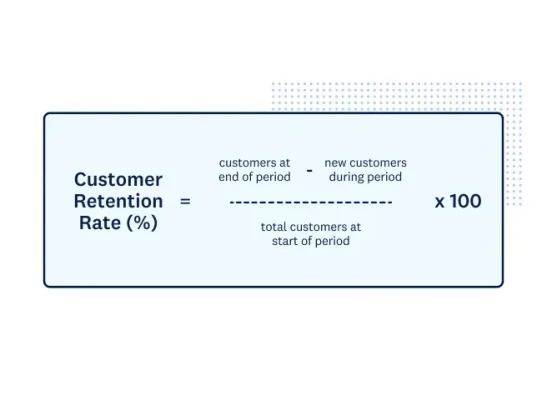
Repeat customer rate
Your repeat customer rate measures how many people who purchase from your business purchase for a second time. Since repeat customers are often responsible for a large portion of annual revenue in many industries, this metric can be very important. The higher your score, the more willing customers are to return to your company to purchase again.
To calculate your repeat customer rate you need two pieces of information:
- The number of customers who have made more than one purchase in a specific period of time.
- The number of unique customers who purchased from your store in a specific period of time
Once you have this information, use this formula to calculate your repeat customer rate: No. of customers who purchased more than once / No. of unique customers.
Purchase frequency
Your purchase frequency metric shows you how often customers purchase your goods or services.
Calculating your purchase frequency metric is similar to calculating your repeat purchase rate. Use the same time period you chose for your repeat purchase rate (such as a single quarter) and then divide your store’s total number of orders by the number of unique customers.
The formula looks like this: Purchase Frequency = No. of orders placed (over a time period) / No. of unique customers (over the same time period). For example, Q2 Purchase Frequency = number of orders in Q2 divided by the number of total customers in Q2.
Average order value
The average order value (AOV) metric can help you determine how much your customers spend, on average, when they make a purchase.
You should calculate the average order value using the same time frame set for your repeat purchase and purchase frequency rates.
From there, you simply divide your yearly revenue by the number of orders your business processed.
The average value order equation looks like this: AOV = total revenue earned / No. of orders placed.
Customer value
The customer value metric helps you understand how much each customer is truly worth to your business. To calculate it, multiply your purchase frequency and average order value together.
Here’s the formula: Customer Value = Purchase Frequency x AOV.
By determining your customer value, you can accurately track your efforts over time and understand the power of customer retention.
Importance of customer retention
Customer retention has multiple benefits for businesses of any size, regardless of whether they’re brand-new or well-established organisations.
Customer retention mainly capitalises on the ease of turning existing customers into repeat ones. By focusing on people who have already signed up for your services or purchased a product, you can reap many benefits for the long-term health of your business.
Here are several other benefits of customer retention.
Cost savings
Acquiring new customers is expensive. In fact, it costs five times more to acquire a new customer than to retain an existing one.
To find new customers, it’s likely that you’ll have to make significant investments in marketing, advertising or events, or offer enticing discounts to get people through the door or onto your website. These can be costly activities that can eat into your profits. Keeping the customers you already have can actually save you money on expensive promotional activities.
Positive word-of-mouth marketing
Loyal customers save you money on acquisition costs and add significant value to your marketing strategy.
Happy and loyal customers are more likely to refer your brand to their peers and people are more likely to value and trust recommendations from people they know.
By keeping your customers happy, you can generate a new stream of customer referrals that help bring even more people to your business.
Better bottom line
Focusing on customer retention saves your business money, thus benefitting your bottom line. That’s why retention activities can be such a powerful engine for business profits. It doesn’t take a big increase in retention to make a big difference in your profits.
Increasing your customer retention rate by even 5% can increase your company’s overall revenue by between 25 and 95%.
Maybe that’s why retention is such a high priority for CX pros. In our State of CX research report, 43% of customer experience teams say customer retention is a top focus. In addition, over a third (35%) say they will focus on increasing customer retention.
Factors influencing customer retention
Several factors can influence customer retention, from pricing to service and loyalty programmes. Understanding how these various elements have an impact on retention can provide companies with the insights needed to improve it.
Here are the main factors that influence customer retention:
- Pricing: Customers always seek the best value when choosing products or services. Although this doesn’t mean you have to offer the lowest prices in your industry, it’s a good idea to research what customers think is an appropriate price for your product or service. A SurveyMonkey pricing survey can help you find this information quickly and easily.
- Quality: If a customer considers your product to be high quality and reliable, they’re more likely to buy again. Improving your services or product quality will help.
- Delivery: Particularly for businesses offering physical products, delivery speeds can have a significant impact on customer retention. With two-day shipping for most companies, customers don’t want to wait around.
- Customer service: Whenever a buyer has an issue, their first response will be to contact your customer service teams. A flawless and useful customer service experience can boost satisfaction, loyalty and retention.
- Loyalty benefits: Implementing a customer loyalty programme can enhance customer satisfaction and lead to repeat purchases.
Focusing on just one of these areas won’t radically improve your customer retention. Instead, a holistic approach where you iterate on each area and continually improve will deliver the best results.
Related reading: 50 examples of great customer satisfaction survey questions
Strategies for improving customer retention rates
Customer retention won’t improve overnight and it needs to be more than a one-off effort. However, you can improve it over time by combining strategies at key customer touchpoints and continuously optimising these areas.
Here are the leading strategies you can use to improve customer retention.
Gather customer feedback
Customer feedback is a vital tool for increasing customer retention rates and reducing customer churn. Use a customer satisfaction survey to ask your customers what they think about your products, services and the experiences you deliver. Collecting this kind of feedback can help you ensure that you are meeting customer expectations and also help you understand where your company is falling short.
Using feedback to make improvements that matter to your customers is the most effective way to create an exceptional customer experience and increase loyalty. You can use customer feedback to:
- Build better customer loyalty programmes: Should you offer discounts? How often? Or should you focus on freebies and hidden perks? Use surveys to find out what consumers really want and take the guesswork out of developing a loyalty programme for your customers. Get started quickly by leveraging a customer loyalty survey template.
- Harness brand loyalty in your product launches: Build your brand loyalty so your customers are ready to purchase when new products come out. Use surveys to test how your messaging and advertising campaigns will resonate with key customer segments before you proceed with your launch.
- Improve your products: Is your customer service department at the root of loyalty problems? Is there something wrong with the products you provide? Or is your competition just really, really good? Know where your hotspots are and fix them with surveys.
The more customer data you have, the wider your context will be for interacting with those customers. Collecting data across all of your customer touchpoints will help you identify and improve upon your customer experiences.
Personalised customer experiences
According to SurveyMonkey research, 72% of customers say that personalisation of products and services is important when considering brands they like. By offering personalised experiences, your customers are more likely to identify positively with your brand.
How exactly does a company create these personalised experiences? The answer is through customer data. By collecting data and using it to segment your audience, you can create products, services, experiences and communications that resonate with your target audience.
Personalisation is already happening in most customer experiences. Around 86% of CX pros say that they provide a personalised experience all or most of the time.
As your business increases its personalisation efforts, your customers will feel seen and spoken to. Over time, this can reduce customer churn, increase loyalty and help boost your business’s success.
Proactive customer service
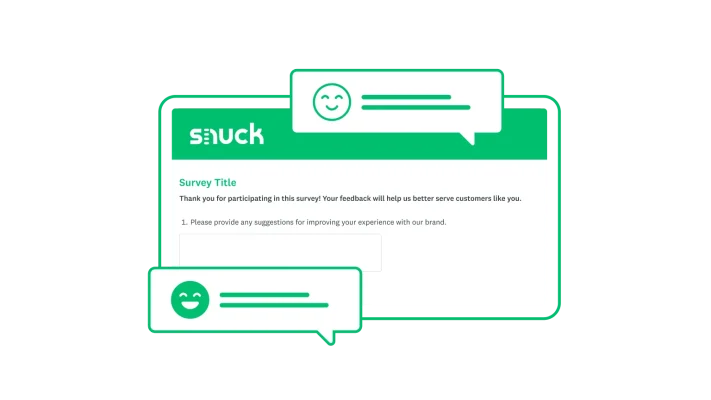
Your loyal customers don’t expect that they will never have an issue with your products or services. However, they do expect that when one arises, your company will fix it quickly and effectively.
Create a strong support system for your customers by communicating effectively and enabling customer service reps to help customers both before and after they make a purchase. Offering the right level of support when needed can prevent customers from getting frustrated and turning to a competitor.
Speed is of the essence when a customer issue arises. Even if you simply reply to each customer issue by letting them know you’re looking into it, this enhanced communication is reassuring to customers. They feel that you’re taking their issue seriously and when you follow up fast, they feel satisfied with the results.
Related reading: The ultimate guide to customer service
Loyalty programmes and incentives
Loyalty programmes are an excellent way to incentivise repeat purchases. When you reward customers for shopping regularly with you, you motivate them to buy more. Loyalty programmes can come in many shapes and sizes. You could offer discounts for certain purchase quantities, money-back policies or rewards points.
Another effective way of encouraging repeat purchases is to send your first-time buyers a discount code after they’ve made their initial purchase. It can nudge them to return again and become regular customers.
Offering a discount code can also encourage customers who haven’t purchased from you for a while to return, as they’re reminded of your products or services and tempted by the additional value.
Communicate with your customers
The importance of communication doesn’t end with fixing issues: customer communications should happen proactively and on a regular basis.
Create a newsletter that informs customers about company news, product updates or launches, personalised offers and service success stories. Want to go above and beyond? Use your CRM data to personalise your emails to your most loyal customers and celebrate key milestones in their relationship with your brand.
Your customers will feel seen and valued and that leads to greater retention and loyalty.
Continuous improvement and feedback
Creating an effective feedback loop can improve customer loyalty. If your customers have gone out of their way to leave feedback, your company should respond to it. Your response may vary depending on the type of feedback you receive.
Positive feedback could include a suggestion to write a public review or recommend your services to a friend. If you receive negative feedback, you may want to connect with the customer personally or provide details about steps your company can take to resolve a situation.
The important factor underlying both of these outcomes is the response itself. Closing the feedback loop will help inspire customers to continue giving your company insights into their experiences.
By continuously collecting feedback, customer data and information from customer touchpoints, you’ll have the information you need to iterate your processes positively. Over time and through continuous improvement, you can create better customer experiences. If your customers feel more satisfied with your company, they’re likely to return for more.
Related reading: How to follow up with NPS detractors, promoters and passives
Examples of customer retention tactics
Some companies stand out from the crowd with their effective customer retention management tactics. These great customer retention examples can inspire you when you’re creating your own retention plan.
Starbucks
The Starbucks Rewards programme is a great example of a customer retention strategy that sets the standard for customer loyalty.
Using the Starbucks app, customers can earn rewards for every purchase they make. Customers can use their rewards later to get free food and drinks. Since payment for all orders in the app comes via the app itself, this generates a huge amount of customer data.
Starbucks uses this data to gain a deeper understanding of what each customer needs and creates highly personalised offerings to encourage follow-on purchases.
Amazon Prime
Amazon’s Prime membership programme is both a customer loyalty and customer experience programme. Customers pay an annual fee to join, which differentiates it from most other customer loyalty programmes. In return, they receive extensive benefits, such as same-day delivery, access to a vast library of streaming music and video options, and exclusive offers and discounts.
Amazon Prime makes purchases effortless. You can purchase with just a swipe when using a smartphone. By making purchases as easy as possible, Amazon Prime encourages customers to return again and again to purchase anything they need. Plus, since customers pay for the service, it also delivers revenue to the company.
Nike
Nike knows that people are more likely to engage with sports, fitness and exercise if they’re part of a group. Customers who are invested in fitness are also more likely to invest in fitness gear and services. Nike offers a membership programme that provides benefits such as free shipping, exclusive clothing and gear, discounts and offers to build a sense of community and loyalty to their brand.
Nike also offers apps and partnerships that tap into the unique interests of their customers. The Nike Run Club lets solo runners partner up with other runners online, replicating the sense of teamwork and the good-natured competition associated with real-life running clubs. These free apps and partnerships boost Nike’s brand image and awareness while also encouraging the purchasers of its clothing to go out and stay active.
When those clothing items become worn with use, the members of the Run Club already have Nike in mind and are likely to go back and purchase from them again.
How to improve customer loyalty
Customer loyalty, satisfaction and retention are all directly linked. As customers feel more satisfied with your business, they’ll return for more, enhancing loyalty and improving retention. There are several ways in which you can improve customer loyalty, ranging from quick fixes all the way up to product improvement and iteration.
Here are some leading strategies that you can use to improve customer loyalty.
Creating emotional connections
The emotional connection between a customer and your brand connects them to your company. How customers perceive and identify with your brand affects the entire customer experience. By creating emotional connections, you can enhance customer loyalty and ensure that your customers choose you over your competitors.
There are several factors that can have an impact on a customer’s emotional connection with your brand:
- Products and services: Great products and services are the ultimate way to make a positive impression on your customers. Deliver unforgettable experiences to keep your brand top of mind.
- Support teams: Whenever a customer has a problem, a friendly, efficient and helpful support team will streamline the process of resolving an issue and leave a positive impression. Better customer experiences with your support team will help boost customer loyalty.
- Brand personality: Some brands are down to earth, whereas others are more formal and professional. Wherever your company is on this scale will have an impact on the type of customers you attract. Aligning your company voice with your target audience will help improve loyalty.
- Brand values: Our recent research reveals that 70% of consumers are very likely to purchase from a brand that shares their environmental values. Clearly stating and abiding by your economic, social and environmental brand values will help create an emotional connection with your audience.
Every single customer touchpoint is an opportunity for your brand to shine.
Consistent brand messaging and values
Customers value consistency, especially regarding how you present yourself to the world. Your business should develop guidelines for your company’s voice, values and tone. Brand guidelines will help everyone who creates content for your company to write in the voice that you want to project to the world.
A clear and consistent brand experience will help improve brand performance for your target audience. As customers become more familiar with your business, your voice and messaging will become recognisable and stand out to the audience you are trying to attract.
Consistent brand messaging also helps present your brand as a professional entity. Confused messaging, inconsistent brand identity or a disconnect in corporate values will reduce the chances of customers identifying with your company.
To establish the best-possible connection with your customers and enhance loyalty, present a consistent identity across all platforms and mediums.
Exceptional product and service quality
One of the driving factors that influences customer loyalty is the services and products that you offer. Regardless of how well you manage every other aspect of the customer experience, your offerings are still one of the most important factors.
A company that consistently delivers high-quality products and services will amass a supportive audience who love what they do. By enhancing your products, refining your services and giving customers more of what they want, you’ll create fans for life.
Collecting feedback, closing the feedback loop and improving your products and services with data-driven insights will help radically enhance customer loyalty.
Community engagement and advocacy
Another powerful way to improve customer loyalty is to establish programmes that support a community or a movement that is aligned with your company values. Advocating for causes that are authentic to your company’s ethos can demonstrate that your company is a trusted partner that has a relatable and relevant corporate identity.
Your business can explain the reasons for supporting its chosen cause via blogs, emails or social media. Moreover, you can engage with your audience on these channels to enhance a sense of community. Actively listening to what people say and responding to them will help cultivate loyalty to your brand.
Measuring and monitoring loyalty: Key metrics for assessing customer loyalty
Customer loyalty metrics are the best way to monitor customer loyalty. You can benchmark these metrics to measure your progress over time or you can compare your own business to industry-wide metrics.
Here are some of the most important customer loyalty metrics you can use.
Net Promoter® Score (NPS)
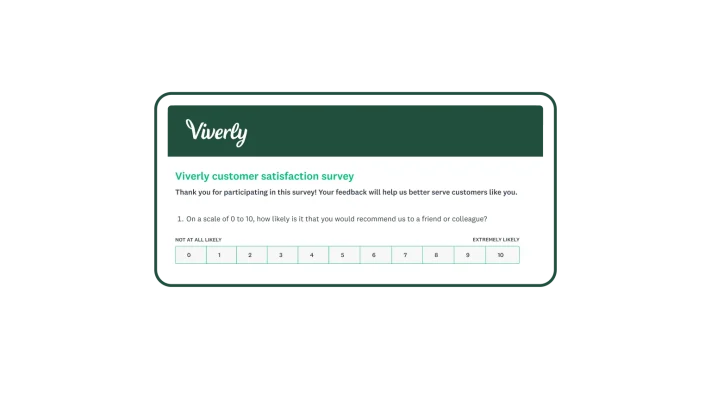
The Net Promoter Score is a popular and useful metric for measuring customer loyalty. Its efficacy lies in its simplicity. It asks one question: “How likely are you to recommend our business to a friend or colleague?”
Respondents will then answer the question on a scale of 0 to 10, with 10 being extremely likely and 0 being extremely unlikely. Here’s some insight into what each score means:
- 9 or 10: These respondents are promoters, i.e. people who are highly likely to recommend your business and exhibit a high degree of loyalty.
- 7 or 8: These responders are passives, i.e. people who don’t have a strong opinion about your business.
- 6 or below: These respondents are detractors, i.e. people who actively found your business unfavourable in places.
To calculate your NPS score, you subtract the percentage of detractors from the percentage of promoters.

Each industry has a different definition of a good NPS score. However, you can generally expect any rating above 0 to be good, anything above 50 to be excellent and anything above 75 to be phenomenal. Use the NPS benchmark for your industry for further insight.
Assessing your NPS over time will help your business measure its overall customer loyalty and pinpoint areas for improvement.
Customer Effort Score (CES)

The Customer Effort Score measures the relative effort that it takes a customer to achieve a certain outcome with your business. For example, you could use a CES score to:
- Measure how effective customer service is.
- Determine whether customers believe your checkout is efficient.
- Determine how easy it is to navigate your site.
A CES survey asks customers whether they disagree or agree with the following: “[Company Name] made it easy to X]”, where X is whatever you would like feedback on.
You can then follow up this closed-ended question with an open-ended one that asks them to explain their choice. You can also ask a respondent to choose from seven answer choices that range from strongly disagree (1) to strongly agree (7).
Below is how you calculate CES:
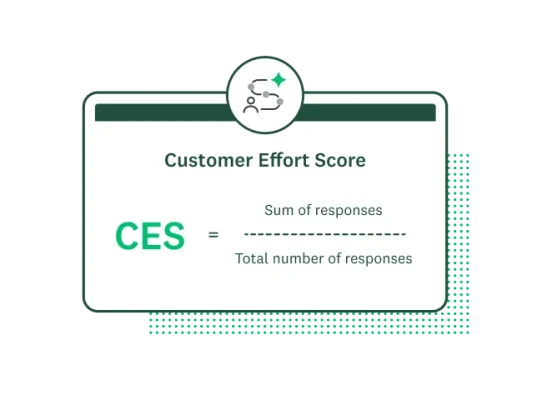
A CES over 5 is good, whereas a score lower than 5 could suggest you need to improve. Using CES surveys across all your major touchpoints will help you continuously improve the customer experience.
SurveyMonkey research suggests that 82% of customers will back out of an online purchase due to a difficult or negative experience. If a customer finds your website hard to navigate or encounters hidden fees at checkout, they’ll probably click away. This research demonstrates why CES is so important, as it can help to reduce customer frustration and boost loyalty.
Customer Satisfaction (CSAT) Score
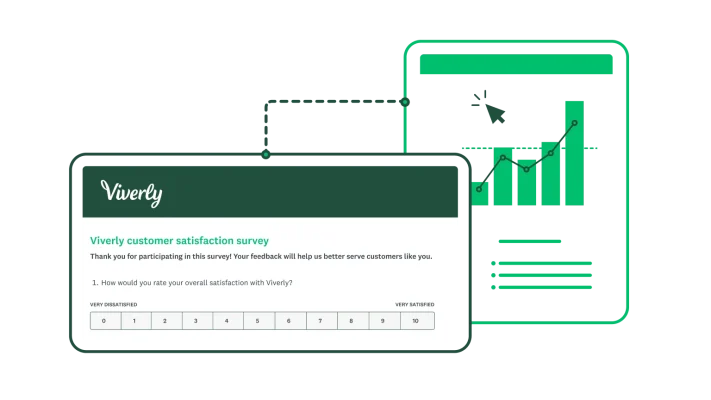
The Customer Satisfaction Score is a general customer experience and loyalty metric that measures customer satisfaction. It asks the question: “How would you rate your overall satisfaction?”, with customers responding based on your services, products and interactions.
Most commonly, you give customers the opportunity to respond on a scale of 1 to 5, with 5 being very satisfied and 1 being very unsatisfied. To calculate your CSAT, you can take the number of 4 and 5 responses and divide them by the total responses x 100.
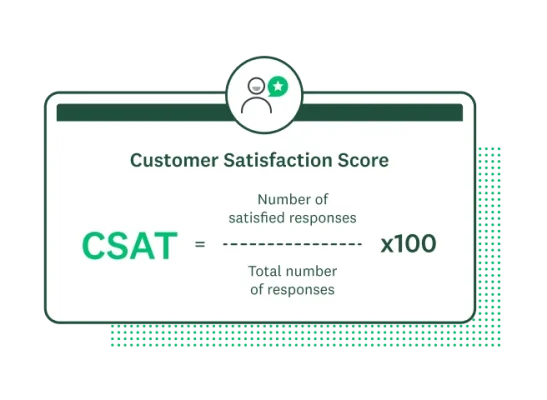
This method will give you a final score as a percentage. This percentage will be the total number of satisfied customers (4s or 5s) out of your total number of customers. You can easily benchmark the CSAT score against other companies in your industry.
Measuring and improving your CSAT over time will help incrementally measure improvements to the customer experience and enhance customer loyalty.
Purchasing satisfaction
Every single customer touchpoint is an opportunity for your business to deliver a winning customer experience. You can trace customer satisfaction across various touchpoints and iterate upon them using data-driven strategies to improve customer loyalty.
Here are some other purchasing satisfaction survey templates that you could use to gather quantitative and qualitative feedback:
Analysing and acting on customer feedback
Growing your business for the long term isn’t just about gaining as many new customers as possible: it’s even more powerful to turn those first-time purchasers into regular buyers, and that’s what optimising your customer retention rate can help you do.
Start by calculating your customer retention metrics and then use one or more of the customer retention strategies above to boost your retention rate and bottom line.
The most important element in any customer retention strategy is finding out what your customers think about your products, services and brand by soliciting and acting on customer feedback. Engaging with your customers, adapting to their feedback and continuously iterating on your offerings will help enhance your customer loyalty and boost retention.
Discover more resources

Customer satisfaction survey templates
Explore our customer satisfaction survey templates to rapidly collect data, identify pain points and improve your customer experience.

See how Ryanair collects customer insights at scale
Discover how Ryanair uses SurveyMonkey and its Microsoft Power BI integration to track 500k monthly CSAT surveys and improve customer experiences.

How to identify customer needs
Refine your market research approach with our guide to identifying customer needs and what UK shoppers are looking for in 2024.

See how woom enhances its employee and customer experience
Discover how woom uses SurveyMonkey to launch multilingual surveys at scale, improve the employee experience and capture customer insights.
See how SurveyMonkey can power your curiosity
Net Promoter, Net Promoter Score and NPS are trademarks of Satmetrix Systems, Inc., Bain & Company, Inc. and Fred Reichheld.